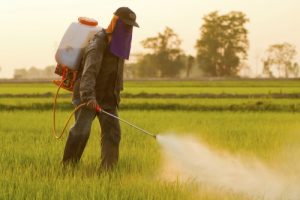What is the most heavily used pesticide in California? Is it glyphosate (Roundup)? Atrazine? Chlorpyrifos? Actually, it’s none of the above. According to a new report sponsored by the National Institute of Environmental Health Sciences (NIEHS), the answer is elemental sulfur. Approximately 46 million pounds of sulfur were applied to crops in California in 2013, note the authors of the report, 7 researchers in environmental health, children’s health, and occupational and environmental medicine at the University of California at Berkeley (UC Berkeley). The researchers examined the association between agricultural use of elemental sulfur and lung function and respiratory symptoms in children living in agricultural communities in California.
“The study linked reduced lung function, more asthma-related symptoms and higher asthma medication use in children living about a half-mile or less from recent elemental sulfur applications compared to unexposed children,” states a press release from UC Berkeley’s media office and referenced at the NIEHS site.
Previous studies have looked at the effects of elemental sulfur crop treatment on the respiratory health of agricultural workers, but this is the first study that looks specifically at how the respiratory health of children is affected.
Registered for use
The high use of sulfur for agricultural pest control results from its availability and effectiveness as well as EPA’s view that the substance has “low toxicity, and its use as a pesticide poses very little known hazard to people and non-target species.” Accordingly, the EPA has registered sulfur for use as an insecticide, fungicide, or rodenticide on several hundred food and feed crops and ornamental, turf, and residential-site use.
Increased asthma medication
The researchers examined associations between lung function and asthma-related respiratory symptoms in hundreds of children living near fields where sulfur had been applied.
The study found associations between poorer respiratory health and nearby elemental sulfur use. A tenfold increase in the estimated amount of sulfur used within 1 kilometer (km) of a child’s residence during the year before pulmonary evaluation was associated with a 3.5-fold increased odds in asthma medication usage and a twofold increase in odds in respiratory symptoms such as wheezing and shortness of breath.
The study also found that each tenfold increase in the amount of elemental sulfur applied in the previous 12 months within a 1-km radius of the home was associated with an average decrease of 143 milliliters per second (mL/s) in the maximal amount of air 7-year-old children could forcefully exhale in 1 second. For comparison, research has shown that exposure to maternal cigarette smoke is associated with a decrease of 101 mL/s after 5 years of exposure.
The researchers used regression models to control for maternal smoking during pregnancy; season of birth, particulate matter air pollution; breastfeeding duration; child’s sex, age, and height; technician; and other covariates.
Regulatory change sought
“Given elemental sulfur’s widespread use worldwide, the study authors call urgently for more research to confirm these findings and possible changes in regulations and application methods to limit impacts of sulfur use on respiratory health,” states the news release.
The study was published in NIEHS’s Environmental Health Perspectives and is available here.

